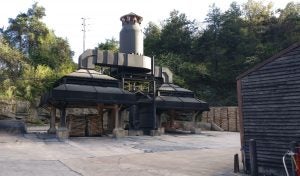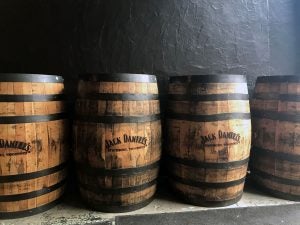A plan to redirect distiller’s spent grains used as feed into an energy startup could have a major impact on this community’s cattle production.
At the tail end of spring, Lynchburg, Tennessee-based whiskey brand Jack Daniel’s roiled the local agricultural community by announcing that it would phase out access to a product colloquially known as “slop” — the distiller’s spent grains that many farmers use as a low-cost, nutritious cattle feed. The future would be to send the slop to 3 Rivers Energy Partners, a relatively young company attempting to build a reputation on “green energy opportunities.”
“As we have continued to increase capacity at the distillery to meet the world’s demand for our Tennessee Whiskey, we have had to look at alternate and environmentally sustainable options for the end use of these byproducts,” Jack Daniel Distillery‘s then-General Manager Larry Combs said in a May 19 letter to farmers in Lynchburg and surrounding Moore County.
The response was immediate — and heated — especially among long-time producers who remember this same kind of thing happening in the 1980s, a time when Jack Daniel’s cut slop production by 80 percent, pushing many farmers out of business.

Soon after Jack Daniel’s distributed its letter, farmers began meeting one-on-one with Combs and his staff. Concerns were voiced, ideas were generated, and an alternate path was urged.
“It would be a major blow, no doubt about it,” said Ray Henshaw, whose family has been buying slop since the early 1960s. “I’ve got to take what they say seriously and look at other options.”
Slop costs farmers who haul it off only about a half-dollar per ton, so economic concerns were at the forefront. It’s a reason grain byproducts from distilleries and breweries around the country are prized by the livestock industry, and why so many cattle operations thrive near these kinds of businesses. In most instances, there’s actually more cost for farmers in the truck and fuel than in the hauled product itself.
Yet without slop in Lynchburg, converting an operation’s equipment to distribute commodities instead of liquid slop is a capital-intensive endeavor.
“The profit margin is going to go down. There’s just no way around that,” Henshaw said. “My thought at the time was about what was going to be the next step for me.”
The potential shuttering of farms means land faces the threat of being subdivided for residential living, turning hundred-acre cattle operations into small-acre housing tracts for people lured to Tennessee by its lack of an individual income tax.
It’s a move that seemingly would smack in the face of the land-conservation legacy of the founding family of Jack Daniel’s parent company, Brown‑Forman Corp.
So just a week after Jack Daniel’s announced the new direction for its fermentation byproduct, company leaders told a gymnasium full of fretful farmers at the Jack Daniel Employee Resource Center that it would instead keep slop distribution in place for farmers for a while, while acknowledging that it will look different in the coming years.
Formally known as the Feeder Cow Program, the recycling of the distiller’s spent grains is one of numerous stewardship initiatives at Jack Daniel Distillery, which also include water conservation, upcycling sugar maple charcoal, and woodland preservation.
Similar feeder programs are in place at other distilleries and craft breweries, especially in neighboring Kentucky — such as Bardstown Bourbon Co. and Green River Distilling Co. — where the product is referred to as “stillage.”
In Lynchburg, Jack Daniel’s is undoubtedly a focal point of the community. Dating back to 1866, it has the first registered distillery in the United States. Fast forward over 150 years, and the company is responsible for more than 50 percent of the county’s property taxes. The business has long given money to local school systems and athletics, as well as to groups such as 4-H.

And while the idyllic small-town square, with a courthouse in the middle, used to embrace an easy-going and simpler way of life, today, much of the square is dominated by gift shops and other avenues catering to the tourism industry.
After all, Jack Daniel’s is a business. Financial solvency through marketing, merchandising, and manufacturing is necessary.
The Feeder Cow Program, currently serving about 100 local farmers, has been in place for decades, and it is a way for the Jack Daniel Distillery to unload a byproduct that would be costly to otherwise dispose of in an environmentally safe manner. Some estimates put access to slop at a $40 million value to the farmers in Moore County.
Generally speaking for a 500-pound calf, a farmer may feed 8 to 10 gallons of slop a day; a 900-pound animal may need 20 gallons. Holstein heifers, common in Moore County, can consume more since they grow up to 1,200 pounds. Cattle smaller than 500 pounds need grain in addition to slop because they can’t consume enough dry matter through slop alone.
This program has minimal costs for Jack Daniel’s, but if 3 Rivers Energy is willing to pay a premium for the spent grains, it could explain why this is so appealing to the distillery. (3 Rivers, however, wouldn’t disclose the financial terms it reached with Jack Daniel’s.)
Combs’ revised plan is to continue the Feeder Cow Program for the next two years until 3 Rivers is ready to begin accepting the distillery’s byproduct — at which point much less slop would likely be available for farmers.
However, 3 Rivers, too, will have a byproduct that it will be looking to unload, and the company plans to offer that as a fertilizer.
“This project will significantly reduce the amount of energy Jack Daniel’s would need to produce their whiskey,” said John F. Rivers, CEO of 3 Rivers Energy. “It will create enough renewable natural gas to supply around 10,000 homes annually and create enough much-needed fertilizer for between 20,000 and 30,000 acres.”
The 3 Rivers Energy facility is expected to cost upward of $100 million to build, and the company hopes it will take about 18 months to build. Yet while the plans were for the site to be up and running by fall 2023, local officials have said that the property it’s being built on isn’t going to be available until the first day of 2023. So that has put it six months behind the Jack Daniel’s partnership announcement from the get-go.
Rivers said that this is the first facility of its kind to be operating at such a large scale and that no public grant money is being used for the project. Over the summer, a land-use exception was sought instead of rezoning to help move the project forward.
Rivers said the technology his company uses includes a series of components, starting with an anaerobic digester, similar to what is found using manure on dairy farms. Anaerobic digestion is a process involving the breakdown of organic matter such as Jack Daniel’s spent grain by bacteria in the absence of oxygen. For biogas production, the organic matter is placed in a reactor containing complex microbial communities.
“Instead of putting manure in it,” he said, “we’re putting corn stillage in there from the distillery, and it’s an anaerobic process.”
The results are the liquid biogas and a digestate, which is the resulting fertilizer.
According to the U.S. Environmental Protection Agency, biogas is composed of 50 percent to 75 percent methane with carbon dioxide, hydrogen sulfide, water vapor, and small amounts of other gasses. To create 3 Rivers’ renewable natural gas, the company said, the biogas is purified by removing the carbon dioxide, hydrogen sulfide, and water.
“The digester needs a minimum amount [of distiller’s spent grains] just to function, so once it comes online the total available stillage will decrease temporarily,” The Lynchburg Times reported Combs as saying.

Jack Daniel’s makes about 500,000 gallons of the spent grains a day, and agricultural producers currently haul off about 300,000 gallons of that — the same amount that Jack Daniel’s expects to send to the digester. A concern was raised that that would leave a shortfall for agricultural producers. However, if Jack Daniel’s completes a planned distillery expansion on time, allowing the whiskey-maker to increase production 10 percent every year as expected, that’s an additional 100,000 gallons available just a few years down the road once the 3 Rivers Energy facility is completed.
“I don’t know how that’s going to affect everything,” said Moore County Extension Director Larry Moorehead. “Jack Daniel’s is growing so fast, that their biggest problem seems to be getting warehouses built to store the whiskey. If they get this increase, it’s not going to hurt us as bad as it sounds like it would’ve at the beginning.”
Ultimately, it would mean 3 Rivers gets the 300,000 daily gallons it needs, and farmers would get a sizable share too, as much as 70 percent of the current numbers, Combs speculated to local media.
Yet, would the timing of the Jack Daniel Distillery expansion leave too great a gap for producers to bridge? And would 70 percent levels force farm operations to shut down or at least seek secondary sources of income?
“The company founders, myself included, we come from the farm community, we both live on farms. My children are the fourth generation raised on my farm,” Rivers said. “So we … are doing things with that in mind. This project is 100 percent about finding better ways to do things from farming to producing whiskey and producing natural gas.”
Perhaps the biggest questions that remain relate to the quality of the fertilizer 3 Rivers would be able to distribute and potential environmental impacts it would have on the region.
According to Moorehead, 3 Rivers said that what comes out of the digester was expected to have a 22/7/7 N-P-K ratio (nitrogen, phosphorus, and potassium).
“But the problem with that is: It’s going to be somewhere between 3 and 5 percent dry matter,” Moorehead said, compared with slop, which is about 8 percent dry matter. “So you’d end up putting so much water on. For instance, on hay land, we’d have to put on 3,000 or 4,000 gallons to the acre to get the N,P, and K that we’d need, if their analysis is right.”
Initially, 3 Rivers told the community it would be about 6 percent dry matter, but engineers revised that number during a meeting with farmers. Even with the original figure, it would take over 10,000 gallons of the digester’s product per acre of corn. And revising the dry matter expectations downward reduces the amount of fertilizer farmers get, Moorehead explained.
There are also concerns that during a particularly rainy year, when grounds are saturated and applications of so many gallons isn’t feasible, it may be hard for 3 Rivers to get rid of its fertilizer.
Yet, until 3 Rivers actually starts to make some of the fertilizer, and farmers are able to get a real test on it, “We don’t know how high it’s going to be in anything,” Moorehead said.

Even distribution plans for the fertilizer have people skeptical. 3 Rivers said that it’s aiming to put in lines to pump the fertilizer as far away as Manchester, which is roughly 25 miles. Yet this kind of infrastructure is expensive; a recent project to put a new gas line in Moore County cost in the vicinity of $10 million to $12 million. 3 Rivers’ CEO did not respond to questions about the cost and logistics of its pipeline plans, nor about where the 10,000 homes it says it could supply are located (Moore County has fewer than 6,400 residents total).
“I think they have a lot of hurdles to cross between here and there,” Moorehead said. “I don’t know what the final answer is going to be, and neither does anyone else.”
Farmers are largely in a wait-and-see status, and those like Henshaw who are in their 50s and 60s and closer to retirement age may be more able to absorb a massive change to their operation than a younger farmer who was relying on the affordable feed source.
Henshaw said a significant reduction in access to the Feeder Cow Program won’t prompt him to quit farming entirely, but he expects he’d scale back to where he has very few cattle and would seek more off-farm income sources.
“In farming, you’ve got challenges every day,” he said, “and some of them you can overcome, and some of them you can’t.”
Ryan Tipps is the founder and managing editor of AGDAILY. The Virginia Tech graduate has covered farming since 2011, and his writing has been honored by state- and national-level agricultural organizations.



